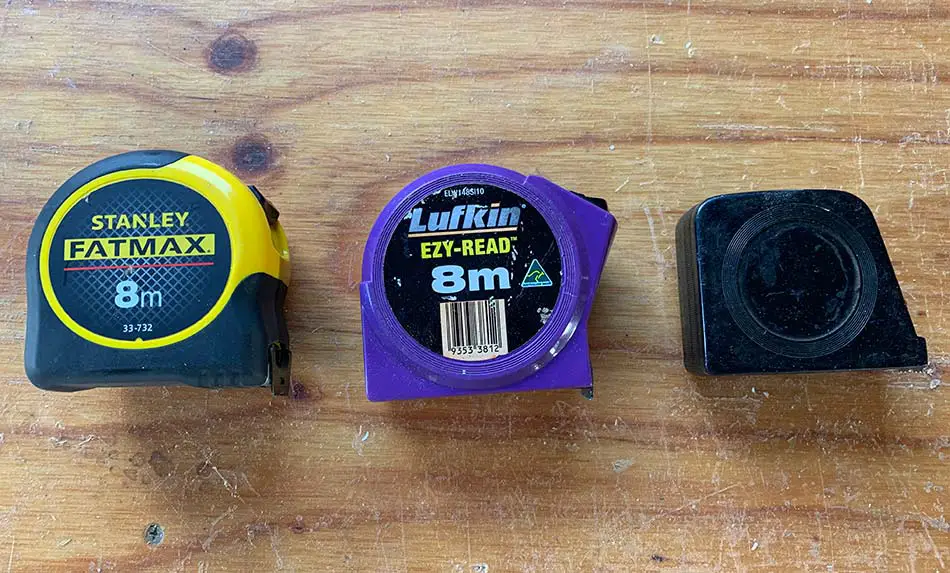
A tape measure is probably the most important tool in your workshop. Without a tape measure, you will be unable to cut timber to accurate sizes or measure things for fit.
Tape measures come in different sizes mainly in the length. If you are just using it in your workshop, a 5 meter or 8-meter tape is plenty big enough. If you are doing a lot of outside work then you may want to look into a 10 meter or in extreme cases, 30-meter tape measure.
Tape measures also come in imperial or metric sizes. This may well be a personal preference based on where you are from.
Over the years I find that tape measures should be easy to read and sit well in your hand. I have found that these tape measures have worked very well for me.
How To Choose The Best Tape Measure (Things you didn’t know)
There are a number of factors to consider before rushing out and buying a tape measure. You will need to select one that fits your needs and these factors are what I consider important:
- Determine what length will you be measuring most often
- What unit of measure suits you best?
- Can you read the measurements?
- Accuracy is always the most important factor
- Look at the width of the blade
- Does the case fit well in your hands?
- Do you need a good locking mechanism?
After many years in the woodworking industry, I have thrown away more tape measures than I can remember, mainly due to being careless when choosing the right one.
Be aware, that the trusty tape measure is the most important tool in your workshop! Without it, we would all be stuck.
I will explain each of these items I consider important in a little more detail below so that you don’t make the same mistake I did.
What Length Will You Measure Most Often?
Most people think that a bigger tape measure is always better but this is certainly not true especially if you only ever plan to measure wood that is less than 1 meter long.
By thinking about this, you can decide what length of tape is best suited to you. Some will need to constantly measure things that are 20 meters long while most of us might only need a few meters.
I always use a 5-meter tape measure in my workshop because I would never use anything longer. On the other hand, I do have a 30-meter tape measure which I use outside and in the garden.
A nice tape measure that is a good allrounder is this 8-meter long tape.
What Unit Of Measure Do You Use?
Now I’m not going to go into the great metric vs imperial battle but this will be very important to each individual.
It is important to choose a tape measure that you can read and understand comfortably.
Some people prefer the imperial unit of measure while others just love metric. Either way is correct but always get one that you would most likely relate to and can understand.
Can You Read The Measurements?
The most important part of selecting the right tape measure would be your ability to read it! Let’s face it, it’s no good to you if you can’t see or read what the measurements are.
Be sure to pull the tape out and have a close look at how the measurements are written. I have found that different brands write the measurements on the blade differently.
Some appear to have largely defined markings while others have more intricate markings. Once again, neither is correct but please choose one that’s easy for you to see without having to squint your eyes.
Accuracy Is Very Important
This one goes without saying, but always check your tape measure for accuracy. Usually, the better brands of tape measures will be more accurate so don’t be afraid to spend a little more to get one that’s good.
Accuracy can be checked by marking at a predetermined size and then lifting the tape and placing the 100mm mark at the end of the wood and see if you get the same dimension.
Accuracy usually comes from the hook end of the tape measure. I explained this in great detail in this article.
To go a bit deeper, most good tape measures fall under one of 3 classes.
- Class I – the most accurate tape measure you can buy. Class I will be within ±1.1mm at 10 meters.
- Class II – the most common tape measures found at any decent store is mostly class II and are more than accurate enough for most people. At 10 meters these tapes will be accurate within ±2.3mm.
- Class III – the least accurate type and not commonly available
Take a look at the end of this article where I explain the accuracy in an easy-to-follow table.
Tape Measure Blade Width Does Matter
The width of a tape measure blade will ultimately determine how far out you can stretch the tape without it kinking and falling to the floor.
I find there is nothing more frustrating than a narrow tape that is hard to push out far. If you find you will mostly work alone, a wider blade will make for stronger tape.
A wider blade is also necessary if you are working outdoors in the wind. A narrow blade is perfect for those small tapes you use in your workshop when measuring small items.
Does The Case Fit Well In Your Hands?
Comfort is an important factor when using your tape measure. This may be not the most important on the list, but certainly worth considering before you buy.
Do You Need A Good Locking Mechanism?
Your work may require you to lock off the tape to prevent it from rolling up while you measure. If this is important to you, please check the tape you intend to buy to ensure the locking mechanism locks well and is easy to get off.
It’s Time To Buy!
Now that you have considered all of these items, you will most likely make a good decision on buying your next tape measure. As I said, it is a very important tool in any workshop and should last you a long time.



